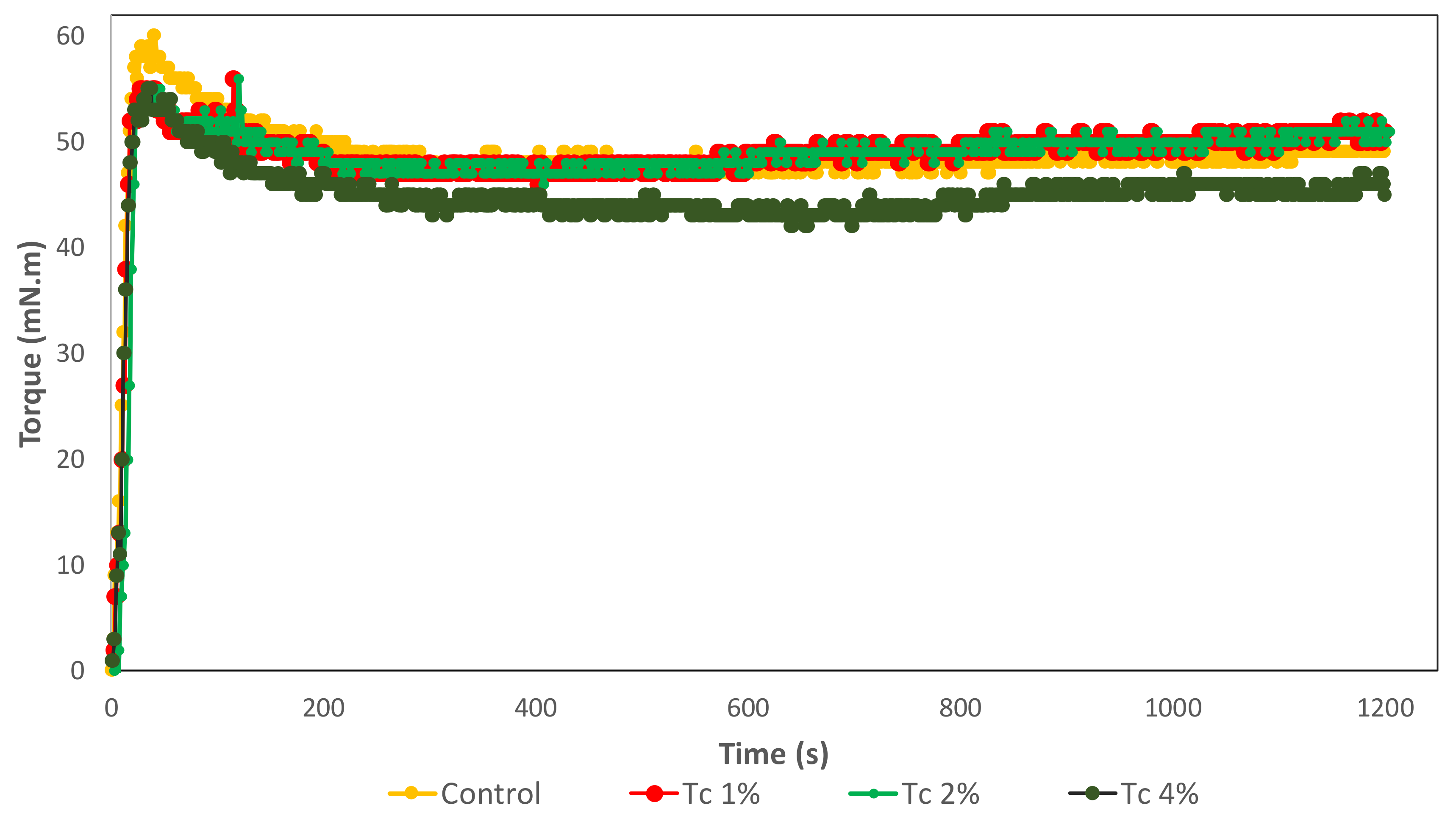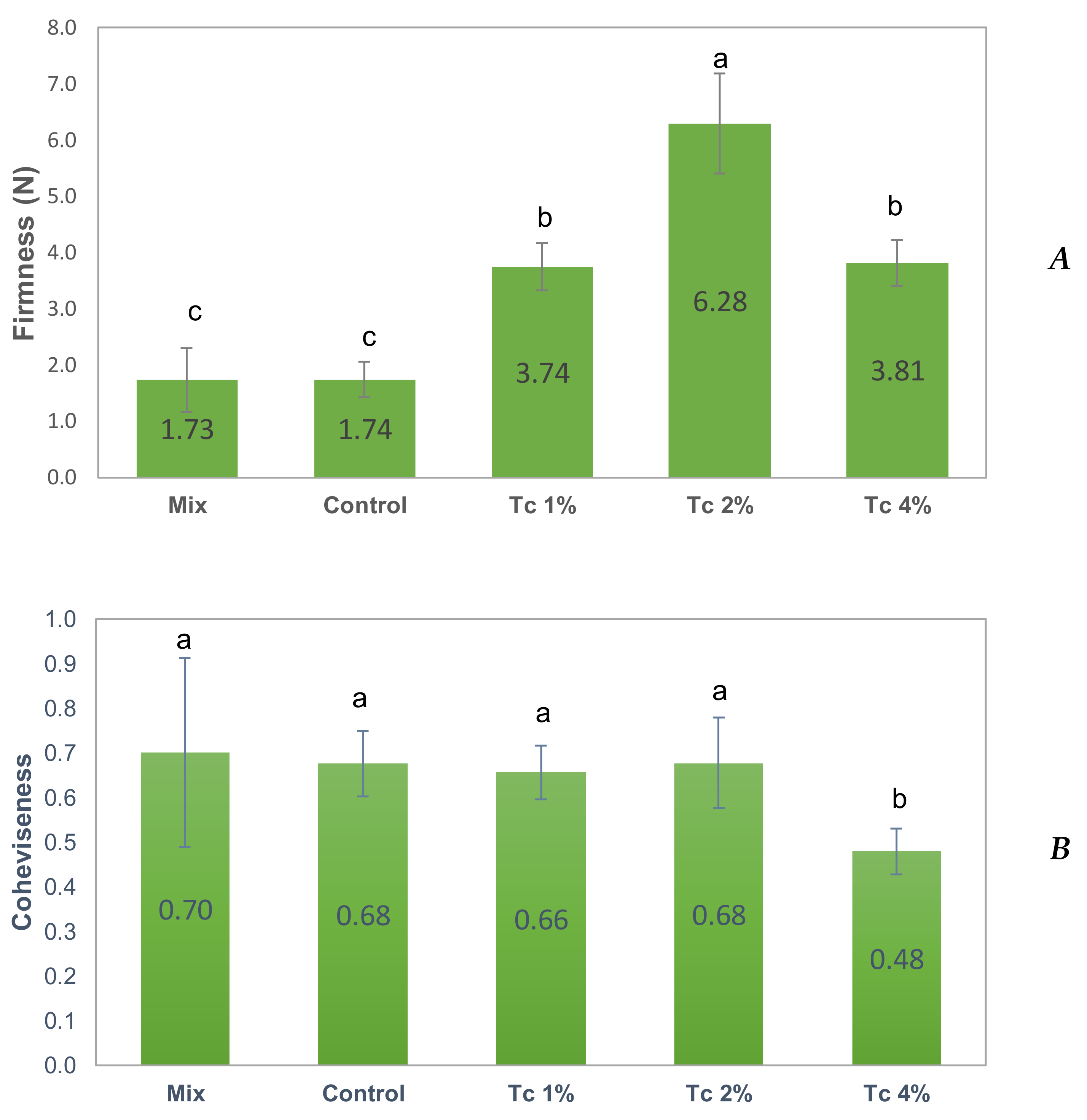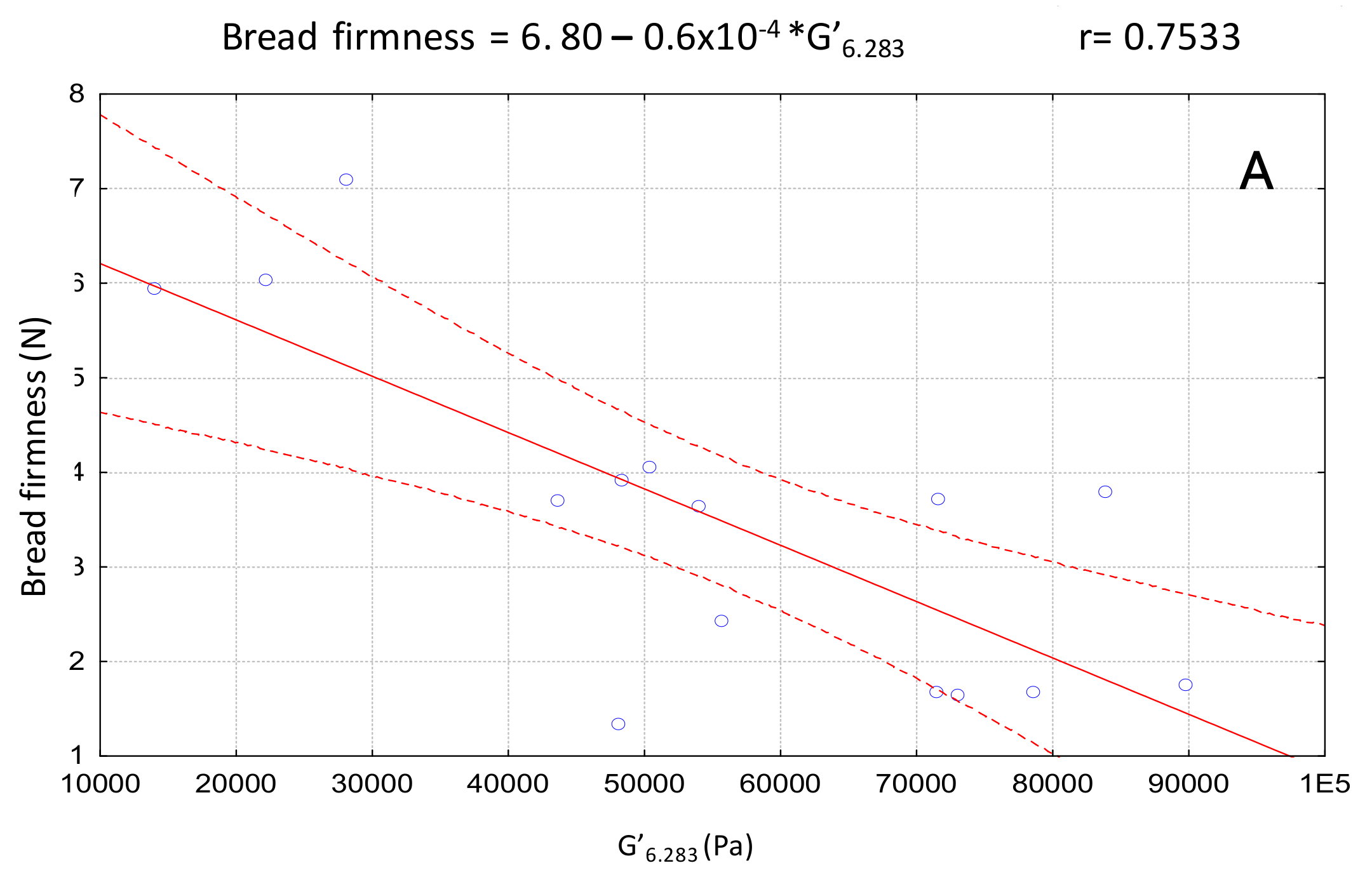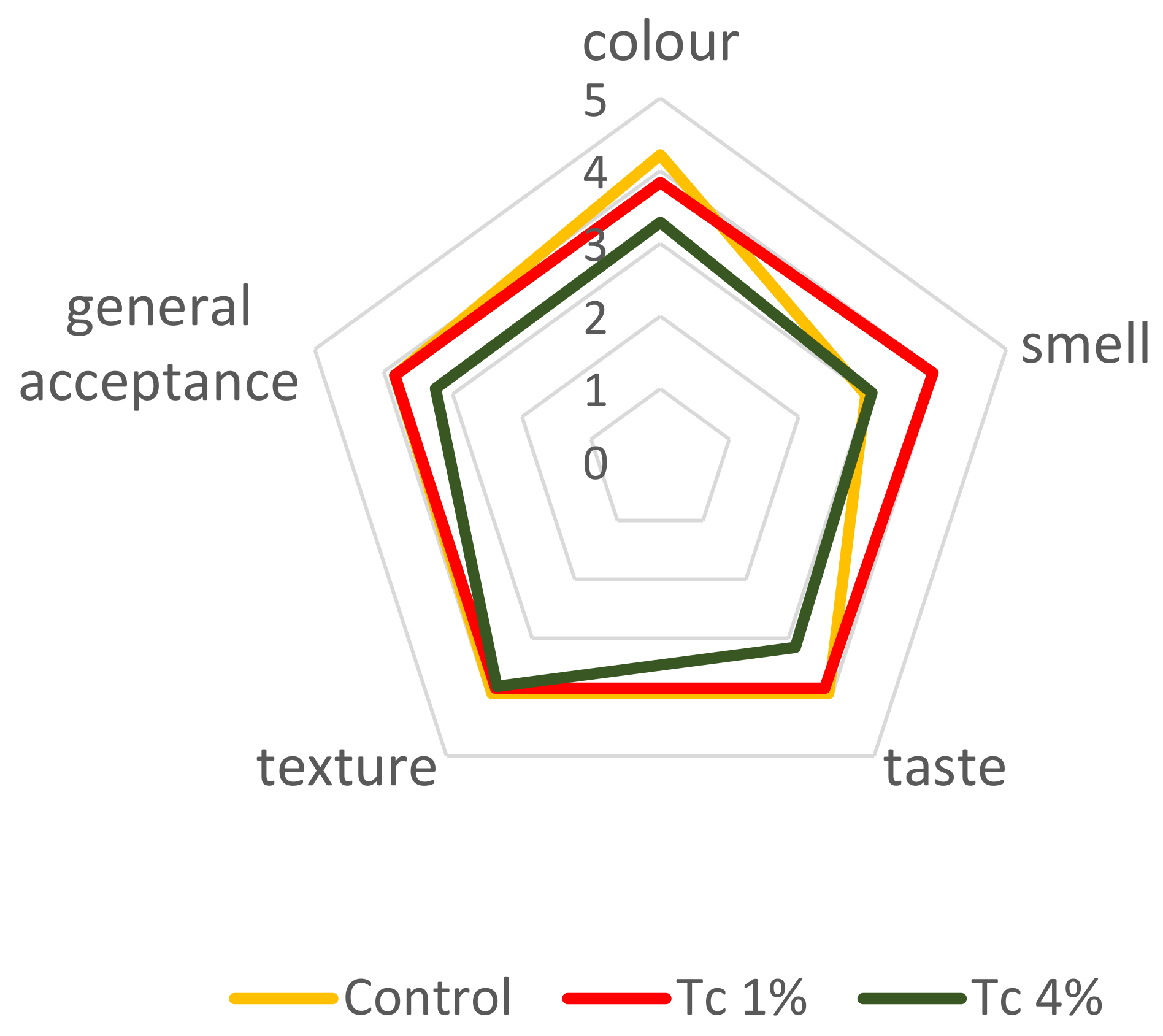Tetraselmis chuii as a Sustainable and Healthy Ingredient to Produce Gluten-Free Bread: Impact on Structure, Colour and Bioactivity
Abstract
:1. Introduction
2. Materials and Methods
2.1. Raw Materials
2.2. Preparation of the Samples
2.3. Mixing Behaviour of the Dough
2.4. Viscoelastic Behaviour of the Dough
2.5. Evaluation of the Bread Texture
2.6. Evaluation of the Bread Volume
2.7. Evaluation of the Bread Colour
2.8. Evaluation of the Bread Bioactivity
2.9. Sensory Evaluation
2.10. Statistical Analysis
3. Results and Discussion
3.1. Impact of Tetraselmis chuii Addition on the Dough Rheology
3.1.1. Empirical Methods—MicrodoughLab
3.1.2. Fundamental Methods—Small Amplitude Oscillatory Shear Measurements (SAOS)
3.2. Impact of Tetraselmis chuii Addition on the Breadmaking Properties
3.3. Correlations between Breadmaking Properties and Dough Rheology
3.4. Impact of Tetraselmis chuii Addition on the Bread Bioactivity
3.5. Sensory Evaluation
4. Conclusions
Author Contributions
Funding
Acknowledgments
Conflicts of Interest
References
- Koyande, A.K.; Chew, K.W.; Rambabu, K.; Tao, Y.; Chu, D.-T.; Show, P.-L. Microalgae: A potential alternative to health supplementation for humans. Food Sci. Hum. Wellness 2019, 8, 16–24. [Google Scholar] [CrossRef]
- Leach, A.M.L.; Gallowaya, J.N.; Bleeker, A.; Erisman, J.W.; Khon, R.; Kitzes, J. A nitrogen footprint model to help consumers understand their role in nitrogen losses to the environment. Environ. Dev. 2012, 1, 40–66. [Google Scholar] [CrossRef] [Green Version]
- Batista, A.P.; Gouveia, L.; Bandarra, N.M.; Franco, J.M.; Raymundo, A. Comparison of microalgal biomass profiles as novel functional ingredient for food products. Algal Res. 2013, 2, 164–173. [Google Scholar] [CrossRef] [Green Version]
- Khan, M.I.; Shin, J.H.; Kim, J.D. The promising future of microalgae: Current status, challenges, and optimization of a sustainable and renewable industry for biofuels, feed, and other products. Microb. Cell Factories 2018, 17, 36. [Google Scholar] [CrossRef]
- Lafarga, T. Effect of microalgal biomass incorporation into foods: Nutritional and sensorial attributes of the end products. Algal Res. 2019, 41, 101566. [Google Scholar] [CrossRef]
- Lafarga, T.; Mayre, E.; Echeverria, G.; Viñas, I.; Villaró, S.; Acién-Fernández, F.G.; Castellari, M.; Aguiló-Aguayo, I. Potential of the microalgae Nannochloropsis and Tetraselmis for being used as innovative ingredients in baked goods. LWT Food Sci. Technol. 2019, 115, 108439. [Google Scholar] [CrossRef]
- Bernaerts, T.M.M.; Panozzo, A.; Doumen, V.; Foubert, I.; Gheysen, L.; Goiris, K.; Moldenaers, P.; Hendrickx, M.E.; Van Loey, A.M. Microalgal biomass as a (multi)functional ingredient in food products: Rheological properties of microalgal suspensions as affected by mechanical and thermal processing. Algal Res. 2017, 25, 452–463. [Google Scholar] [CrossRef]
- Bernaerts, T.M.M.; Gheysen, L.; Foubert, I.; Hendrickx, M.E.; Van Loey, A.M. The potential of microalgae and their biopolymers as structuring ingredients in food: A review. Biotechnol. Adv. 2019, 37, 107419. [Google Scholar] [CrossRef] [PubMed]
- Raymundo, A.; Nunes, M.C.; Sousa, I. Microalgae biomass as a food ingredient to design added value products. In Valorising Seaweed by-Products; Domínguez, H., Torres, M.D., Eds.; Nova Science Publishers: Hauppauge, NY, USA, 2019; ISBN 978-1-53615-398-9. [Google Scholar]
- Fradique, M.; Batista, A.P.; Nunes, M.C.; Gouveia, L.; Bandarra, N.M.; Raymundo, A. Incorporation of Chlorella vulgaris and Spirulina maxima biomass in pasta products. Part I: Preparation and evaluation. J. Sci. Food Agric. 2010, 90, 1656–1664. [Google Scholar] [CrossRef] [PubMed]
- Fradique, M.; Batista, A.P.; Nunes, M.C.; Gouveia, L.; Bandarra, N.; Raymundo, A. Isochrysis galbana and Diacronema vlkianum biomass incorporation in pasta products as PUFA’s source. LWT Food Sci. Technol. 2013, 50, 312–319. [Google Scholar] [CrossRef] [Green Version]
- Fradinho, P.; Raymundo, A.; Sousa, I.; Domínguez, H.; Torres, M.D. Edible brown seaweed in gluten-free pasta: Technological and nutritional evaluation. Foods 2019, 8, 622. [Google Scholar] [CrossRef] [PubMed] [Green Version]
- Fradinho, P.; Niccolai, A.; Soares, R.; Rodolfi, L.; Biondi, N.; Tredici, M.R.; Sousa, I.; Raymundo, A. Effect of Arthrospira platensis (spirulina) incorporation on the rheological and bioactive properties of gluten-free fresh pasta. Algal Res. 2020, 45, 101743. [Google Scholar] [CrossRef]
- Gouveia, L.; Coutinho, C.; Mendonça, E.; Batista, A.P.; Sousa, I.; Bandarra, N.M.; Raymundo, A. Functional biscuits with PUFA-ω3 from Isochrysis galbana. J. Sci. Food Agric. 2008, 88, 891–896. [Google Scholar] [CrossRef] [Green Version]
- Batista, A.P.; Nicccolai, A.; Fradinho, P.; Fragoso, S.; Bursic, I.; Rodolfi, L.; Biondi, N.; Tredici, M.R.; Sousa, I.; Raymundo, A. Microalgae biomass as an alternative ingredient in cookies: Sensory, physical and chemical properties, antioxidant activity and in vitro digestibility. Algal Res. 2017, 26, 161–171. [Google Scholar] [CrossRef]
- Batista, A.P.; Niccolai, A.; Bursic, I.; Sousa, I.; Raymundo, A.; Rodolfi, L.; Biondi, N.; Tredici, M.R. Microalgae as funtional ingredientes in savory food products: Application to wheat crackers. Foods 2019, 8, 611. [Google Scholar] [CrossRef] [Green Version]
- Graça, C.; Fradinho, P.; Sousa, I.; Raymundo, A. Impact of Clorella vulgaris addition on rheology wheat dough properties. LWT Food Sci. Technol. 2018, 89, 466–474. [Google Scholar] [CrossRef]
- Nunes, M.C.; Graça, C.; Vlaisavljevic, S.; Tenreiro, A.; Sousa, I.; Raymundo, A. Microalgae cell disruption: Effect on the bioactivity and rheology of wheat bread. Algal Res. 2020, 45, 101749. [Google Scholar] [CrossRef]
- Matos, M.E.; Rosell, C.M. Understanding gluten-free dough for reaching breads with physical quality and nutritional balance. J. Sci. Food Agric. 2015, 95, 653–661. [Google Scholar] [CrossRef]
- Naqash, F.; Gani, A.; Gani, A.; Masoodi, F.A. Gluten-free baking: Combating the challenges – a review. Trends Food Sci. Technol. 2017, 66, 98–107. [Google Scholar] [CrossRef]
- El Khoury, D.; Balfour-Ducharme, S.; Joye, I.J. A review on the gluten-free diet: Technological and nutritional challenges. Nutrients 2018, 10, 1410. [Google Scholar] [CrossRef] [Green Version]
- Figueira, F.S.; Crizel, T.M.; Silva, C.R.; Salas-Mellado, M.M. Elaboration of gluten-free bread enriched with the microalgae Spirulina platensis. Braz. J. Food Technol. 2011, 14, 308–316. [Google Scholar]
- Rózylo, R.; Hassoon, W.H.; Gawlik-Dziki, U.; Siastala, M.; Dziki, D. Study on the physical and antioxidant properties of gluten-free bread with brown algae. CyTA J. Food 2017, 15, 196–203. [Google Scholar] [CrossRef] [Green Version]
- Kokkali, M.E.; Kleinegris, D.M.M.; de Vree, J.H.; Haugsgjerd, B.O.; Samuelsen, T.A.; Oterhals, A.; Kousoulaki, K. Optimising cell wall disruption by bead milling of microalgae biomass for release of nutrients for aquafeed and food applications (preliminary results). In Proceedings of the HydroMedit 2018, 3rd International Congress on Applied Ichthyology & Aquatic Environment, Volos, Greece, 8–11 November 2018. [Google Scholar]
- Fernandes, I.C.X. Desenvolvimento de Pães Sem Glúten Enriquecidos com Tetraselmis chuii. Master’s Thesis, Instituto Superior de Agronomia da Universidade de Lisboa, Lisboa, Portugal, 2019. [Google Scholar]
- Bourne, M. Food Texture and Viscosity, 2nd ed.; Academic Press: London, UK, 2002. [Google Scholar]
- Oktay, M.; Gülçin, Ì.; Kufrevioglu, O.Ì. Determination of in vitro antioxidant activity of fennel (Foeniculum vulgare) seed extracts. LWT Food Sci. Technol. 2003, 36, 263–271. [Google Scholar] [CrossRef]
- Sánchez-Moreno, C.; Larrauri, J.A.; Saura-Calixto, F. A procedure to measure the antiradical efficiency of polyphenols. J. Sci. Food Agric. 1998, 76, 270–276. [Google Scholar] [CrossRef]
- Rufino, M.S.M.; Alves, R.E.; Brito, E.S.; Morais, S.M.; Sampaio, C.G.; Pérez-Jiménez, J.; Saura-Calixto, F.D. Metodologia Científica: Determinação da Atividade Antioxidante Total em Frutas pelo Método de Redução do Ferro (FRAP); Embrapa Agroindústria Tropical: Fortaleza Brasil, 2006. [Google Scholar]
- Storck, C.R.; Zavareze, E.R.; Gularte, M.A.; Elias, M.C.; Rosell, C.M.; Dias, A.R.G. Protein enrichment and its effects on gluten-free bread characteristics. LWT Food Sci. Technol. 2013, 53, 346–354. [Google Scholar] [CrossRef]
- Sahagún, M.; Gómez, M. Assessing influence of protein source on characteristics of gluten-free breads optimising their hydration level. Food Bioprocess Technol. 2018, 11, 1686–1694. [Google Scholar] [CrossRef]
- Mariotti, M.; Lucisano, M.; Pagani, M.A.; Ng, P.K.W. The role of corn starch, amaranth flour, pea isolate, and Psyllium flour on the rheological properties and the ultrastructure of gluten-free doughs. Food Res. Int. 2009, 42, 963–975. [Google Scholar] [CrossRef]
- Mohammadi, M.; Azizi, M.H.; Neyestani, T.R.; Hosseini, H.; Mortazavian, A.M. Development of gluten-free bread using guar gum and transglutaminase. Ind. Eng. Chem. 2015, 21, 1398–1402. [Google Scholar] [CrossRef]
- Korus, J.; Witczak, M.; Ziobro, R.; Juszczak, L. The influence of acorn flour on rheological properties of gluten-free dough and physical characteristics of the bread. Eur. Food Res. Technol. 2015, 240, 1135–1143. [Google Scholar] [CrossRef] [Green Version]
- Yazar, G.; Duvarci, O.; Tavman, S.; Kokini, J.L. Non-linear rheological behaviour of gluten-free flour doughs and correlations of LAOS parameters with gluten-free bread properties. J. Cereal Sci. 2017, 74, 28–36. [Google Scholar] [CrossRef]
- Wang, K.; Lu, F.; Li, Z.; Zhao, L.; Han, C. Recent developments in gluten-free bread baking approaches: A review. Food Sci. Technol 2017, 37, 1–9. [Google Scholar] [CrossRef] [Green Version]
- Torbica, A.; Hadnacev, M.; Dapcevic, T. Rheological, textural and sensory properties of gluten-free bread formulations based on rice and buckwheat flour. Food Hydrocoll. 2010, 24, 626–632. [Google Scholar] [CrossRef]
- Horstmann, S.W.; Lynch, K.M.; Arendt, E.K. Starch characteristics linked to gluten-free products. Foods 2017, 6, 29. [Google Scholar] [CrossRef] [PubMed] [Green Version]
- Graça, C.; Raymundo, A.; Sousa, I. Yogurt as an alternative ingredient to improve the functional and nutritional properties of gluten-free breads. Foods 2020, 9, 111. [Google Scholar] [CrossRef] [Green Version]
- Tomic, J.; Torbica, A.; Belovic, M. Effect of non-gluten proteins and transglutaminase on dough rheological properties and quality of bread based on millet (Panicum miliaceum) flour. LWT Food Sci. Technol. 2020, 118, 108852. [Google Scholar] [CrossRef]
- Carballo-Cárdenas, E.C.; Tuan, P.M.; Janssen, M.; Wijffels, R.H. Vitamin E (α-tocopherol) production by marine microalgae Dunaliella tertiolecta and Tetraselmis suecica in batch cultivation. Biomol. Eng. 2003, 20, 139–147. [Google Scholar] [CrossRef]
- Francis, F.J.; Clydesdale, F.M. Food Colorimetry: Theory and Applications; The AVI Publishing Company Inc.: Westport, CT, USA, 1975. [Google Scholar]
- Martínez, M.M.; Gómez, M. Rheological and microstructural evolution of the most common gluten-free flours and starches during bread fermentation and baking. J Food Eng. 2017, 197, 78–86. [Google Scholar] [CrossRef]
- Elgeti, D.; Peng, L.; Jekle, M.; Becker, T. Foam stabilization during processing of starch-based dough systems. Innov. Food Sci. Emerg. Technol. 2017, 39, 267–274. [Google Scholar] [CrossRef]
- Ballester-Sánchez, J.; Gil, J.V.; Haros, C.M.; Fernández-Espinar, M.T. Effect of Incorporating white, red or black quinoa flours on free and bound polyphenol content, antioxidant activity and colour of bread. Plant Foods Hum. Nutr. 2019, 74, 185–191. [Google Scholar] [CrossRef] [Green Version]








| Ingredients (g/100g) | Control | Tc 1% | Tc 2% | Tc 4% |
|---|---|---|---|---|
| Buckwheat flour | 46.0 | 45.5 | 45.1 | 44.2 |
| Rice flour | 31.0 | 30.7 | 30.4 | 29.8 |
| Potato starch | 23.0 | 22.8 | 22.5 | 22.1 |
| Tetraselmis chuii | 0.0 | 1.0 | 2.0 | 4.0 |
| Sunflower oil (in relation to flours) | 5.5 | 5.5 | 5.5 | 5.5 |
| HPMC (in relation to flours) | 4.6 | 4.6 | 4.6 | 4.6 |
| Dried yeast (in relation to flours) | 2.8 | 2.8 | 2.8 | 2.8 |
| Sugar (in relation to flours) | 2.8 | 2.8 | 2.8 | 2.8 |
| Salt (in relation to flours) | 1.8 | 1.8 | 1.8 | 1.8 |
| Water Absorption (14% moisture basis) | 69.0 | 69.0 | 69.0 | 69.0 |
| GF Dough | WA (%) | P (mN.m) | DDT (s) | DS (s) | DSO (mN.m) |
|---|---|---|---|---|---|
| Control | 69.0 | 56 ± 1.2 | 48 a | 30 a | 9 a |
| Tc 1% | 69.0 | 51 ± 1.7 | 48 a | 44 a | 7 a |
| Tc 2% | 69.0 | 56 ± 3.8 | 50 a | 44 a | 7 a |
| Tc 4% | 69.0 | 51 ± 1.5 | 48 a | 50 a | 9 a |
| GF Dough | a’ | b’ | a’’ | b’’ |
|---|---|---|---|---|
| Mix | 38397 a | 0.182 d | 13942 a,b | 0.130 a |
| Control | 43446 a | 0.289 a,b | 23896 a | 0.239 a |
| Tc 1% | 31724 a,b | 0.267 b,c | 15642 a,b | 1.497 a |
| Tc 2% | 11639 b | 0.318 a | 6875 b | 0.268 a |
| Tc 4% | 37213 a | 0.249 c | 17555 a | 0.223 a |
| GF Bread | Volume (cm3) | L* | a* | b* | ΔE* |
|---|---|---|---|---|---|
| Mix | 674 b | 89.3 a | 8.5 a | 24.0 a,b | _ |
| Control | 701 a | 94.6 a | 1.4 b | 19.2 c | _ |
| Tc 1% | 642 c | 38.9 b | −1.1 c | 16.2 d | 64 |
| Tc 2% | 612 d | 29.8 b,c | −1.3 c | 27.1 a | 73 |
| Tc 4% | 640 c | 25.7 c | −0.3 c | 22.2 b,c | 77 |
© 2020 by the authors. Licensee MDPI, Basel, Switzerland. This article is an open access article distributed under the terms and conditions of the Creative Commons Attribution (CC BY) license (http://creativecommons.org/licenses/by/4.0/).
Share and Cite
Nunes, M.C.; Fernandes, I.; Vasco, I.; Sousa, I.; Raymundo, A. Tetraselmis chuii as a Sustainable and Healthy Ingredient to Produce Gluten-Free Bread: Impact on Structure, Colour and Bioactivity. Foods 2020, 9, 579. https://doi.org/10.3390/foods9050579
Nunes MC, Fernandes I, Vasco I, Sousa I, Raymundo A. Tetraselmis chuii as a Sustainable and Healthy Ingredient to Produce Gluten-Free Bread: Impact on Structure, Colour and Bioactivity. Foods. 2020; 9(5):579. https://doi.org/10.3390/foods9050579
Chicago/Turabian StyleNunes, Maria Cristiana, Isabel Fernandes, Inês Vasco, Isabel Sousa, and Anabela Raymundo. 2020. "Tetraselmis chuii as a Sustainable and Healthy Ingredient to Produce Gluten-Free Bread: Impact on Structure, Colour and Bioactivity" Foods 9, no. 5: 579. https://doi.org/10.3390/foods9050579
APA StyleNunes, M. C., Fernandes, I., Vasco, I., Sousa, I., & Raymundo, A. (2020). Tetraselmis chuii as a Sustainable and Healthy Ingredient to Produce Gluten-Free Bread: Impact on Structure, Colour and Bioactivity. Foods, 9(5), 579. https://doi.org/10.3390/foods9050579








